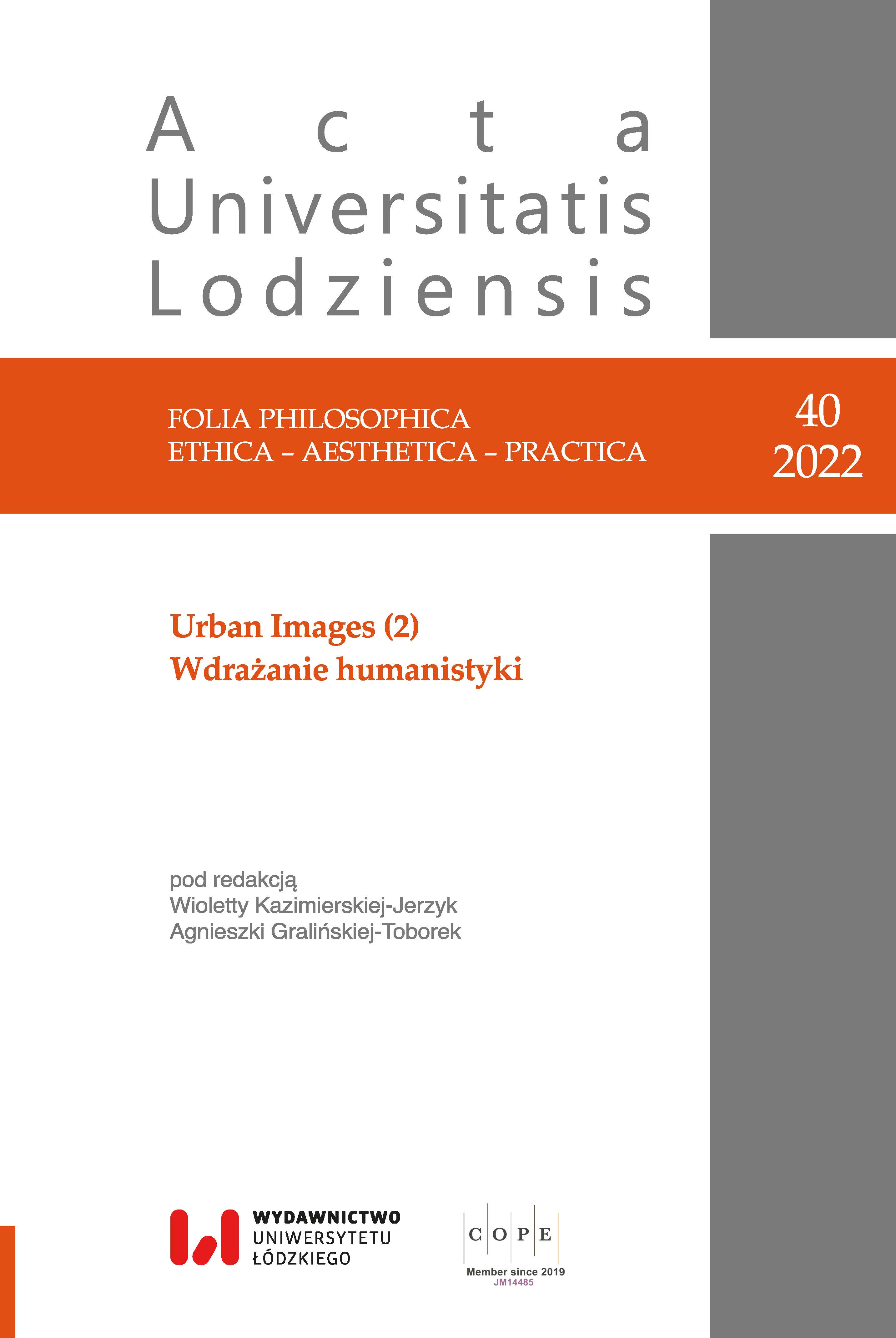Lost Symbols in the Historic City of Puebla in Mexico
DOI:
https://doi.org/10.18778/0208-6107.40.02Słowa kluczowe:
identity, memory, historical centers, landmarks, public space, PueblaAbstrakt
Since its origin, the city of Puebla has had representative elements in its public spaces that have survived for a long time, they are ornamental and utilitarian objects which are landmarks of the city. Street furniture is a benchmark of identity too. All elements have legends, they are references that have given identity to streets and avenues. Natural elements also refer to a city’s identity, like trees. But the natural element that defined origin, trace and growth of the city is one of the least visible. In the sixties, the San Francisco River was piped, as a sign of the new modernity, and today it is a boulevard where thousands of cars pass. Thus, bridges and other types of elements that the population still remember, mainly the elderly, have been forgotten. In recent years, some initiatives have emerged to rescue the historical memory of daily life and the revaluation of representative objects of the city center, such as the Casa Analco Community Museum project, coordinated by the Faculty of Architecture of BUAP in collaboration with residents of the Analco neighborhood. This article discusses both the monuments, their relics, elements of nature that shape the city's identity, as well as the gradual loss of these symbols.
Bibliografia
Bohigas, O. (1986). Reconstrucción de Barcelona. Madrid: Mopu.
Google Scholar
Colom, F. (ed.). (2016). Forma y política de lo urbano. La ciudad como idea, espacio y representación. Bogotá: Crítica.
Google Scholar
Danko, S., (2008). Humanizing Design through Narrative Inquiry. Journal of Interior Design, 31 (2), pp. 10–28.
Google Scholar
DOI: https://doi.org/10.1111/j.1939-1668.2005.tb00408.x
Flores Chávez, J. E. (2020). Procesos de significación y resignificación de una ciudad, Temuco 1881–2019. Arquitecturas del Sur, 38 (58), pp. 24–43. https://doi.org/10.22320/07196466.2020.38.058.02
Google Scholar
DOI: https://doi.org/10.22320/07196466.2020.38.058.02
Gómez, D. (2017). Así lucía la Casa del Perro antes del sismo del 19 de septiembre. Parabolica.MX [online]. Available at: https://www.parabolica.mx/2017/local/item/6021-asi-lucia-la-casa-del-perro-ante-del-sismo-del-19-de-sebruary [Accessed: 11 June 2021].
Google Scholar
Hernández, A. (2000). La vivienda en los barrios tradicionales de Puebla: El Alto, Analco, La Luz y Xanenetla [Master’s Thesis]. México Distrito Federal: Universidad Nacional Autónoma de México.
Google Scholar
Hernández Sánchez, A. (2009). El espacio público en el Centro Histórico de Puebla-México [doctoral thesis]. Barcelona: Universitat de Barcelona.
Google Scholar
Hernández, M. A. (September 11, 2017). Rosewood, el hotel para pudientes que despoja a Puebla de su patrimonio. La Jornada de Oriente [online]. Available at: https://www.lajornadadeoriente.com.mx/puebla/rosewood/#:~:text=Rosewood%2C%20el%20hotel%20para%20pudientes%20que%20despoja%20a%20Puebla%20de%20su%20patrimonio,-Por%20Mart%C3%ADn%20Hern%C3%A1ndez [Accessed: 11 June 2021].
Google Scholar
Landín, Á. (2011). La imagen de la Ciudad segun Kevin Lynch Pt. 1. Mi Diario Urbano [online]. Available at: http://midiariourbano.blogspot.com/2011/09/la-imagen-de-la-ciudad-segun-kevin.html [Accessed: 11 June 2021].
Google Scholar
Leicht, H. (1967). Las Calles de Puebla. Puebla: Commission for Cultural Promotion of the Government of the State of Puebla.
Google Scholar
Lynch, K. (1984). La imagen de la ciudad. Barcelona: Gustavo Gili.
Google Scholar
Margulis, M. (2002). La ciudad y sus signos. Estudios Sociológicos, XX (3), pp. 515–536.
Google Scholar
Paz, N. (2016). Memoria Histórica y Arte Público. On the W@terfront, 47, pp. 7–46.
Google Scholar
Remesar, A. (2019). Del arte público al post-muralismo. Políticas de decoro urbano en procesos de Regeneración Urbana. On the W@terfront, 61 (1), pp. 3–65. https://doi.org/10.1344/waterfront2019.61.6.1
Google Scholar
DOI: https://doi.org/10.1344/waterfront2019.61.6.1
Seydel, U. (2014). Introducción. In Borsò, V. and Seydel, U. (eds.), Espacios históricos – espacios de rememoración: la historia mexicana decimonónica en las letras y la cultura visual de los siglos XX y XXI. México–Düsseldorf: Bonilla-Artigas, Universidad Nacional Autónoma de México, Düsseldorf University Press, pp. 15–78.
Google Scholar
UNESCO (1972). Convención sobre la protección del patrimonio mundial, cultural y natural. UNESCO [online]. Available at: https://whc.unesco.org/archive/convention-es.pdf [Accessed: 11 June 2021].
Google Scholar
UNESCO (2003). Convención para la salvaguardia del patrimonio cultural inmaterial 2003. UNESCO [online]. Available at: http://portal.unesco.org/es/ev.php-URL_ID=17716&URL_DO=DO_TOPIC&URL_SECTION=201.html [Accessed: 11 June 2021].
Google Scholar
UNESCO (2014). Indicadores UNESCO de cultura para el desarrollo. UNESCO [online]. Availa-ble at: https://es.unesco.org/creativity/sites/creativity/files/digital-library/cdis/Patrimonio.pdf [Accessed: 11 June 2021].
Google Scholar
Velasco, E. (2020). Plaza Urbina: tiempo, morfología y memoria. Cuadernos del Centro de Estudios en Diseño y Comunicación [Ensayos], 86, pp. 151–164. Available at: http://www.scielo.org.ar/pdf/ccedce/n86/1853-3523-ccedce-86-151.pdf [Accessed: 11 June 2021].
Google Scholar
Vélez, F. and Guzmán, A. (1997). Cartografía histórica de Puebla. Puebla. México: Gobierno del Estado de Puebla-Instituto de Ciencias Sociales y Humanidades-Benemérita Universidad Autónoma de Puebla.
Google Scholar
Fotos de Puebla. Available at: http://www.fotosdepuebla.org/galeria/index.php/Puebla-Antigua/Ciudad-de-Puebla/Puebla-021 [Accessed: 11 June 2021].
Google Scholar
ILAM Foundation. Available at: https://ilamdir.org/patrimonio/cultural [Accessed: 11 June 2021].
Google Scholar
Phototeca Antica. Available at: https://fototecaantica.net [Accessed: 11 June 2021].
Google Scholar
Puebla Antigua. Twitter, 23 Aprile 2020. Available at: https://twitter.com/PueblaAntigua/status/1253346182631428097/photo/1 [Accessed: 11 June 2021].
Google Scholar
Puebla General Municipal Archive (s/f). Photographic collection of the Municipal Historical Archive of Puebla. Puebla General Municipal Archive.
Google Scholar
Pobrania
Opublikowane
Jak cytować
Numer
Dział
Licencja

Utwór dostępny jest na licencji Creative Commons Uznanie autorstwa – Użycie niekomercyjne – Bez utworów zależnych 4.0 Międzynarodowe.












